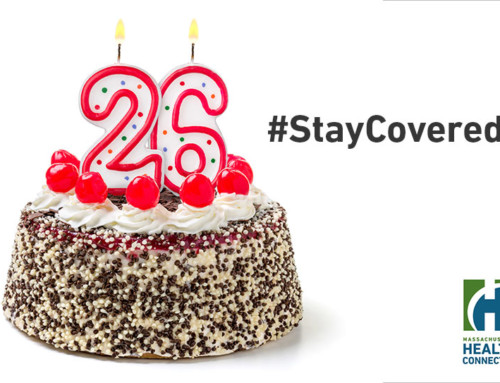Getting health insurance is an important first step in getting and staying healthy. Follow these guidelines to make sure you are taking care of your health and your coverage.
#1 – Understand your health coverage
- Check with your insurance plan to see what services are covered, and know whether you will need to pay out of pocket for any services.
- Be familiar with your costs (premiums, co-payments, deductibles, co-insurance).
- Know the difference between in-network and out-of-network providers.
- Know where and when to send payments for your monthly health insurance premium from the Health Connector.
#2 – Know where to go for care
- Use the emergency department only for life-threatening situations.
- Use your doctor for preventive health or when it’s not an emergency.
- Did you know that because of national healthcare reform, most health plans must cover a set of preventive services like shots and screening tests at no cost to you? Find out more about preventive services for adults, women, and children at https://www.healthcare.gov/preventive-care-benefits/adults/
#3 – Find a provider
- Ask people you trust and/or do research on the internet.
- Check which providers are in your network by searching on your health plan’s website or calling your health plan’s customer service number.
- If you’re assigned a provider and you want to change, call your health plan.
#4 – After you have an appointment with a provider
- Follow your provider’s instructions.
- Fill any prescriptions you were given, and take them as directed.
- Review your explanation of benefits and pay your medical bills.
- Contact your provider, health plan, or the Health Connector with any questions.
#5 – Keep in contact with the Health Connector
- Open your mail—we sometimes send important information about your health insurance.
- Let the Health Connector know right away if you have a change of address or any changes in your family size or income.
Important Words to Know
Here are explanations of some key health insurance words that will help you understand your coverage.
| Provider | Where you get health care services—this could mean a hospital, health center, nurse practitioner, doctor, or pharmacy. |
| Network | The facilities, providers, and suppliers your health insurance plan hascontractedwithtoprovide health care services.
|
| Deductible | The amount you have to pay for health care services before your health insurance plan pays your bills. This cost is on top of your monthly premium cost.
|
| Co-insurance | The amount you have to pay for covered services, usually a percentage. This amount is on top of your deductible and your monthly premium cost.
|
| Co-payment | The amount you may have to pay each time you get health care services or pick up a prescription. This cost is on top of your monthly premium cost and deductible for certain services. A co-payment is usually a set amount, rather than a percentage. |
| Premium | The monthly cost that must be paid for your health insurance plan. It is not included in your deductible, your co-payment, or your co-insurance. If you don’t pay your premium, you could lose your coverage. |
| Out-of-pocket maximum | The most you will have to pay during a policy period (usually one year) before your health insurance plan starts to pay 100% for covered benefits. This limit includes out-of-pocket costs like deductibles, co-insurance, and co-payments. This limit does not include premiums. |









